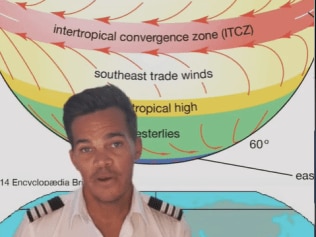Pilot and former Bachelor star Jimmy Nicholson has put forward a theory about what may have caused the terrifying turbulence on Singapore Airlines flight SQ321 last week, in a video which has racked up millions of views online.
Australians onboard the Singapore Airlines flight which experienced severe turbulence this week have arrived home.
56 Australians were on board the Boeing Triple-7 when it made an emergency landing in Bangkok.
12 Australians are in hospital in the Thai capital after suffering injuries.
Passengers were greeted by loved ones and shared what it was like onboard the plane when the incident occurred.
The former Bachelor Australia star who graced TV screens for the ninth season of the show in 2021 has earned a huge following on social media with his videos of everything from DIY tricks, travel tips and flying know how.
Nicholson last week posted a TikTok which has racked up a whopping two million views explaining why he thinks flight SQ321 from London to Singapore encountered bad turbulence.
This article contains features which are only available in the web versionTake me there
He explained there are areas in the world where pilots can expect bad turbulence including a region called the Intertropical Convergence Zone (ITCZ) around the equator.
“This is where the winds from the northern hemisphere converge with the southern hemisphere often causing bad weather and turbulence,” he said.
“The ITCZ changes throughout the year,” he said, pointing to a part of the map outlined in red where the zone was located in May when the incident occurred.
“As you can see from the flight radar, the flight was tracking to Singapore from London and then made a left hand turn and ended up diverting into Bangkok.”
Other theories about what caused the incident include the phenomenon of clear air turbulence, a type of turbulence that occurs with no accompanying visual cues like clouds.
Ambulances were on the scene at Bangkok airport on Monday night (local time) to receive seriously injured passengers off the flight. Picture: AP Photo / Sakchai Lalit
Nicholson also touched on a key piece of information he says the media should have “asked a pilot” about.
“Media are reporting that the flight dropped 6,000ft as a result of this severe turbulence and this is where the media should just ask a pilot,” he said.
“The airplane descended from 37,000ft at six minutes past the hour, down to 31,000 ft at 12 minutes past the hour.
“This is not a sudden drop due to turbulence; this is a controlled descent likely because the aeroplane needed to divert into Bangkok or because they were descending out of the turbulence.”
Nicholson described the event as “very sad and very rare,” reiterating to his followers these sorts of incidents don’t happen very often.
“We do our absolute best to avoid turbulence but sometimes it happens often around the convergence zone that I spoke about earlier,” he said.
Aviation Expert Geoffrey Thomas says there is “indeed” an increase in turbulence in the air.
A 73-year-old man died when a Singapore Airlines flight from London to Singapore experienced extreme turbulence.
Many others have been taken to hospital, with seven critically injured.
“A report done by the University of Reading in the United Kingdom … has shown that over the North Atlantic turbulence has increased over the last 40 years. This is severe turbulence by 55 per cent, moderate turbulence by 37 per cent and light turbulence by 17 per cent,” Mr Thomas told Sky News Australia.
“Those findings can be replicated right across the globe.
“This is all due to changing weather patterns that have impacted aviation.”
His page features a series of videos explaining why turbulence happens and what passengers can do if they are feeling stressed about flying.
“Thanks for putting my mind at ease!” one commenter wrote.
“You’re the reason I am able to fly without having a panic attack. Thank you for this!” said another.
Nicholson spent just over half a decade flying Airbus planes and earlier this year announced a shift to Boeing.

